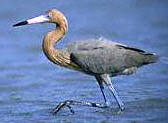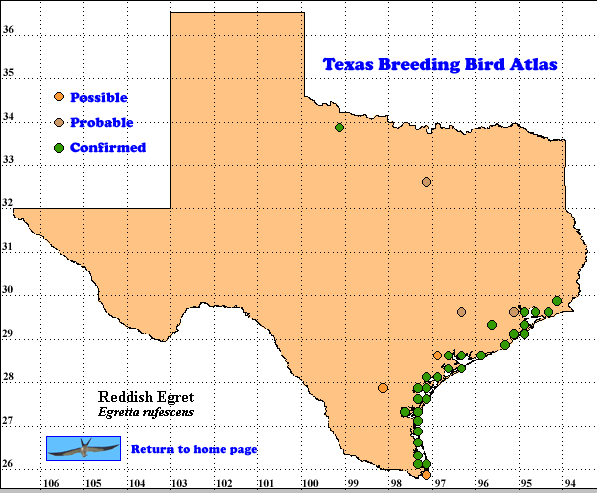The Reddish Egret is a locally common resident of expansive coastal bay and lagoon systems of southern North America, Central America, the northern extremities of South America (rare), and intervening islands. After decimation by the plume trade in the nineteenth century, populations subsequently protected under the Lacey Act have recovered and generally stabilized. However; this species remains the rarest ardeid in North America, with Texas representing a large portion of its worldwide range. Noteworthy characteristics of this species include plumage polymorphism, delayed maturation, low fecundity, high specificity in foraging and nesting habitats, restricted range, and small population size. One weakly differentiated subspecies is recognized, but only the nominate race occurs in Texas (Blake 1977, Howell and Webb 1995, Am. Ornithol. Union 1998).
DISTRIBUTION: In Texas, TBBA data indicate the Reddish Egret breeds along the entire length of the coastline. Inland breeding records for this species, although rare, were reported as possible on Lake Alice (Jim Wells County, 1988), probable on Eagle Lake Reservoir (Colorado County, 1989) and Lake Joe Pool (Tarrant/Dallas Counties, 1988), and confirmed northwest of Rosharon (Brazoria County, 1989) and on Lake Kemp (Baylor County, 1989). Breeding activity was associated with coastal bay habitat in 98% of TBBA records for this species, indicating the dependency of this egret on estuarine wetlands. Highest densities occurred along the southern half of the coastline (latilongs 25097, 26097, 27097, 28096, and 28097), corresponding to the transition from cordgrass (Spartina sp.)-dominated emergent marsh on the upper coast to unvegetated wind-tidal flats on the lower coast.
SEASONAL OCCURRENCE: The Reddish Egret is conspicuous in courtship and nesting behaviors due to its habitat requirements, even though it may comprise only a small percentage of individuals in large, multi-species colonies. Eighty-eight percent of the 219 TBBA records represent confirmed breeding. In Texas, the breeding season extends from early March until late July and occasionally early August (Oberholser 1974). Nesting generally is initiated later with decreasing latitude. Reported egg dates range from March 19 (Oberholser 1974) to July 28 (McMurry 1971).
The Reddish Egret is weakly migratory, with a general southward post-nuptial dispersal along the coast and into Mexico during winter. Late summer inland wandering , especially by young birds, is unpredictable and erratic but often follows major river courses into central and east Texas, especially during dry years when sandbars and mudflats are exposed during low flows. Birds banded in Texas have been recovered in Mexico, Guatemala, and El Salvador (Bent 1926, Telfair and Swepston 1987, Howell and Webb 1995, Paul unpubl.).
BREEDING HABITAT: In Texas, Reddish Egrets utilize the few natural inter-bay islands, emergent shell reefs, and the increasing number of man-made islands created by dredged material (spoil) disposal for breeding. Oberholser (1974) reported that nests are constructed atop brushy Yucca-pricklypear (Opuntia) thickets on dry islands. Bent (1926) observed nesting in small trees, shrubs, and herbage, often over water. Nests consist of elevated flat platforms of sticks smoothly lined with finer twigs, rootlets, straws and grasses. Less frequently; more elaborate, deeply-cupped grass nests are constructed on the ground. The lack of vegetation on unconsolidated sediments of spoil islands and periodic deposition of additional dredged material may limit nest substrate availability.
STATUS: The current breeding range of the Reddish Egret in Texas, based on TBBA data, does not differ from that reported in historical accounts (Audubon 1843, Dresser 1866, Carroll 1909, Pearson 1918,1922, Camp 1922, Bent 1926). The Laguna Madre has consistently accounted for the majority of the Texas population and prior to the 1960s, the majority of Reddish Egrets in Texas bred in one colony, Green Island, located in the lower Laguna Madre (Farmer 1991). Since that time, the population center has shifted northward to Corpus Christi and associated bay systems of the central coast. This shift may be due to pesticide contamination along the highly agricultural lower coast and to the increasing number of spoil islands along the central coast.
Large fluctuations in the statewide abundance and distribution of this egret during the past 4 decades are primarily due to natural and anthropogenic impacts to the Green Island colony (Paul 1991). Trend analysis of Texas Colonial Waterbird survey data (Lange unpubl.) reveal a population peak at the beginning of the 1980s with a subsequent decrease in numbers concurrent with an increase in colony numbers. In 1974, Oberholser reported the species was declining on the upper coast. A 1990 survey (TCWS 1990) estimated 1500 Reddish Egret pairs in Texas, with 500 pairs present on Green Island. The percentage of TBBA records corresponding to Texas Colonial Waterbird Census (TPWD 1978) regions are distributed as: upper coast 30%, middle coast 41%, and lower coast 29%. Analysis of Breeding Bird Survey data (Sauer et al. 1997) suggests a similar distribution, although sample sizes were small.
Due to its ecological specificity and small population size, the Reddish Egret is currently a “Category 2” species for listing under the Endangered Species Act (Dept. Inter. 1989) and listed as “Threatened” by the Texas Parks and Wildlife Department (1993).
Text by Daniel Jones (ca 1998)
Literature cited.
American Ornithologists’ Union. 1998. Checklist of North American birds, 7th ed. Am, Ornithol. Union, Washington, DC.
Audubon, J.J . 1843. The birds of America. Vol. 6. J. J. Audubon, New York.
Bent, A. C. 1926. Life histories of North American marsh birds. Bull. U. S. Nat. Mus. 135, Washington, DC.
Blake, E. R. 1977. Manual of neotropical birds. Vol. 1. University of Chicago Press, Chicago, IL.
Camp, R. D. 1922. Guarding the great Texas heronry. Bird-Lore 24:319-322.
Carroll, J. J. 1909. Down Bird Island way. Wilson Bull. 39:195-207.
Department of the Interior. 1989. Endangered and threatened wildlife and plants; annual notice of review. Fed. Reg. 50 (17).
Dresser, H.E. 1866. Notes on the birds of southern Texas. Ibis 2:23-46.
Farmer, M. 1991. Reddish Egrets of the lower Laguna Madre. USFWS-Lower Rio Grande NWR, Alamo, TX.
Howell, S. N. G. and S. Webb. 1995. A guide to the birds of Mexico and northern Central America. Oxford University Press, New York.
McMurry, S. L. 1971. Nesting and development of the Reddish Egret (Dichromanassa rufescens Gmelin) on a spoil bank chain in the Laguna Madre. M.S. thesis, Texas A&I University, Kingsville, TX.
Oberholser, H. C. 1974. The bird life of Texas. Vol. 1. Univer of Texas Press, Austin.
Paul, R. T. 1991. Status report – Egretta rufescens (Gmelin) Reddish Egret. USFWS, Houston, TX.
Pearson, T. G. 1918. A Reddish Egret colony in Texas. Bird-Lore 20:384-386.
Pearson, T. G. 1922. Herons of the United States. Bird-Lore 24:306-314.
Sauer, J. R., J. E. Hines, G. Gough, I. Thomas, and B. G. Peterjohn. 1997. The North American Breeding Bird Survey results and analysis. Version 96.3. Patuxent Wildl. Res. Cntr., Laurel, MD. < http://www.mbr-pwrc.usgs.gov/bbs>
Telfair, R. C. II and D. A. Swepston. 1987. Analysis of banding and marking nestling Anhingas, Olivaceous Cormorants, Roseate Spoonbills, ibises, bitterns, and egrets in Texas (1923-1983). PWD-BK-7100-152-7/87. Texas Parks and Wildl. Dept., Austin.
Texas Colonial Waterbird Society (Compilers). 1978. Texas colonial waterbird census, 1973-1976. PWD Rpt. 7000-29. Texas Parks and Wildl. Dept., Austin.
Texas Colonial Waterbird Society (Compilers). 1990. Texas colonial waterbird census summary: 1990. Spec.Admin. Rept., Texas Parks and Wildl. Dept., Austin’
Texas Parks and Wildlife Department. 1993. Texas natural heritage program: special animal list. Texas Parks and Wildl. Dept., Austin.

